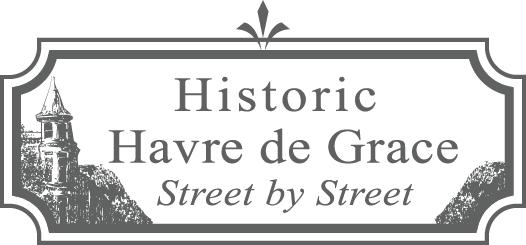Back to All Listings
317-321 St. John Street, Old First National Bank Building, c. 1905
Stop #54 on The Lafayette Trail
This beautifully renovated building was originally constructed in 1905 for the First National Bank of Havre de Grace. Many of the original architectural features remain or have been restored, including the original bank vault. The back expands in a pair of joined towers and there is an interesting overhang covering the side entrance. Next to this large bank building is a smaller building, known as 317 St. John Street, with a few of the same features.
The First National Bank of Havre de Grace was organized in 1883 with president Arthur Vosbury who served until his death in 1891. John A. Russell was one of the first directors and Robert K. Vanneman (1853-1912) was the first cashier (who also helped to organize the bank). Another cashier, William N. Coale, was presented with a gold watch in 1923 for 40 years of service. Coale also served as Mayor from 1917-1919.
Their first bank building was here in 1885 and it was almost a quarter of a century before the First National Bank commissioned William Lewis Plack, a notable Philadelphia architect (who had designed the Methodist Church on Union Avenue) to design this building. Plack was inspired by the Renaissance-revival style made popular at the 1882-1893 Chicago World’s Fair. More specifically, according the architect James T. Wollon, Jr., the building is an adaptation of an 18th-century English gatehouse or garden temple and the street façade may have been taken from the plates in “Magnum in Parvo,” a 1728 book of designs. Designers of the late 19th and early 20th centuries did not hesitate to draw from many styles; Plack and the bank building are no exception and he completed it in 1908. The building is shown on the 1910 Insurance Sanborn Map. The external façade is of Port Deposit granite; each piece of stone was designed, cut and carved to fit in place, and is closest to English Revival. The cornice, made of pressed sheet copper with Renaissance detailing and terra cotta tiled roof are Romanesque Revival.
After the First National Bank consolidated with Havre de Grace Banking & Trust Company as the First National Bank & Trust (in 1956), they moved south to 233 St. John Street. In 1959 the building was sold by G. Bartol Silver as President of First National Bank & Trust to Louis H. Miller and Joseph D. Silverstein (of Joseph’s Department Store) who were partners in real estate. They owned the building for about four years before selling it to Dr. Franklin Henry “Frank” Wolbert (1904-1967) who invested in some local properties and lived on North Union Avenue.
Since its bank days, the building hosted several different retail shops before becoming the elegant venue that it is today. One such store was Leitheisers; after that it was a popular store called Shocket’s that sold fabric and other general merchandise and was described by locals as a first “dollar store.” It was so packed with merchandise that Barb Ely says she was always afraid something would fall and trap her. Shockets was run by Nicholas C. D'Adamo Sr., and his wife, Grace Marie D’Adamo, who ran three other Shocket stores in east Baltimore.
In January 1967, Francis and Katherine G. Bortz purchased the building from Dr. Wolbert (who as many people recall was murdered just months later). The Shocket store continued operating into the mid-1970s when the building was bought by Arvid and Donna Scherpf. For the next decade, the Scherpfs owned this property—they also were the owners of the Havre de Grace Marina on Water Street.
New owners of the building in 1986, along with the smaller 317 St. John Street, were William M. Rickman, Jr. and his wife, Marcia, along with Dr. Gilman D. Grave and his wife, Nancy. The Rickmans owned racetracks and casinos and this was a real estate investment for the couples until they sold the property in 2009. During those years, the building was occupied for a short time by artist-painter Paul Bergtold as his studio and in the early 1990s, this became the “Bank of Memories.” It had fine and estate antiques and run by Bobbi Barrow for several years, with John Spangler presenting jewelry. In 2009 the building was sold to the current owner, 321 St. John Street, LLC.
Restoration of this unique structure required more than 18 months of planning and construction as it was in serious disrepair. Great care was taken by the new owner to preserve historic features including the original mosaic entryway; mahogany floors, doors, and moldings; plaster cornices; marble walls; decorative wrought iron; and the original bank vault. Modernized bathrooms and HVAC systems were installed, as was a ramp for wheelchair access.
This is now the main indoor building of the complex known as La Banque de Fleuve, translated as “The Bank on the River,” which includes 309 to 321 St. John Street, on the east side of the street. It stands as an asset to the streetscape and waterfront of downtown Havre de Grace and to the city. It has become a popular wedding and event venue complete with a seaplane base behind it on the water. This property received an award from the Havre de Grace Historic Preservation Commission in 2011, and is owned by 321 St. John Street, LLC.
County Records
Built 1885. 2792 sq ft, commercial “club house,” 6026 sq ft lot.
Built 1885. 2792 sq ft, commercial “club house,” 6026 sq ft lot.
